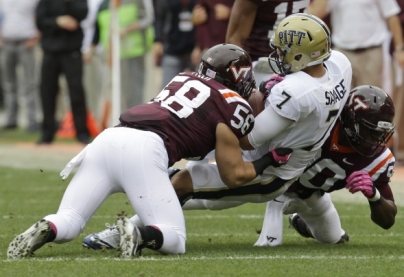By Mike Kuchar
Senior Research Manager
X&O Labs
Twitter: @MikeKKuchar
Editor’s Note: The following research is excerpted from XandOLabs.com special report on Developing a Pressure Check System.
11 Personnel Pressure Checks
Essential Questions/Answers on how to attack 11 personnel:
 Q: What if the tight end is not tied into protection?
Q: What if the tight end is not tied into protection?
A: We’ve found that many defensive coaches aren’t seeing tight ends that are tied into protection. It usually is six-man protection with the back. If that is the case, five to six man pressures can be effective. Keep in mind, a three-by-one closed set does give the opportunity for outside linebackers to get on pressure tracks, because inside linebackers are able to work to number three (the tight end) in coverage. So it may be beneficial to bring perimeter pressures.
Q: What if the tight end is tied into protection?
A: Now with the tight end tied into protection, defenses have a choice to bring pressure to the tight end to get some sort of exterior rush or bring it away from the tight end, if teams are sliding in that direction. We’ve heard many coaches talk about getting that exterior pressure to the tight end side, particularly against sprint out concepts.
Q: How much of the offenses run game are predicated to the three man surface?
A: Some coaches are choosing to design their pressures to the three-man surface side in run-downs. One back power teams or one back zone teams may be affected by a check system designed to bring pressure to the tight end.
Where to Attack
Bud Foster specifically uses an 11 check in his pressure system where he may be having five different calls based off his 11 checks. “The back could be at home, he could be weak or could be strong and we can play three different coverage’s based off of it,” said Foster. “We won’t change the front. If they detached a TE, we may pressure now to the side of the Tight End.”
Scott Donaldson is one of those coaches who prefer an exterior pressure against tight end or three-man surface structures. Although he mentions he doesn’t see many teams that keep the tight end in protection, when he does it negates any opportunity for an outside backer to be an interior rusher. “It really screws up the timing of the blitz when you have a tight end there,” said Donaldson. “The OLB can get cut off. When the tight end is on the field and we are blitzing a tight end, we will limit the blitzes to the ones that we know time up with a tight end. Anytime the SS has to go inside, its’ no good. Instead we’ll send him outside.”
Garrett Gillick, the former defensive coordinator at Bentley College and now the linebackers coach at the University of New Hampshire, spends more time analyzing where the back is in 11 personnel. “If they come out in 11 personnel with the back weak and we want to run Seattle (detailed below), then we come off the weak side,” said Gillick. “If the back is strong we want to attack the back. We will say check ‘Seattle’ to the back.”








